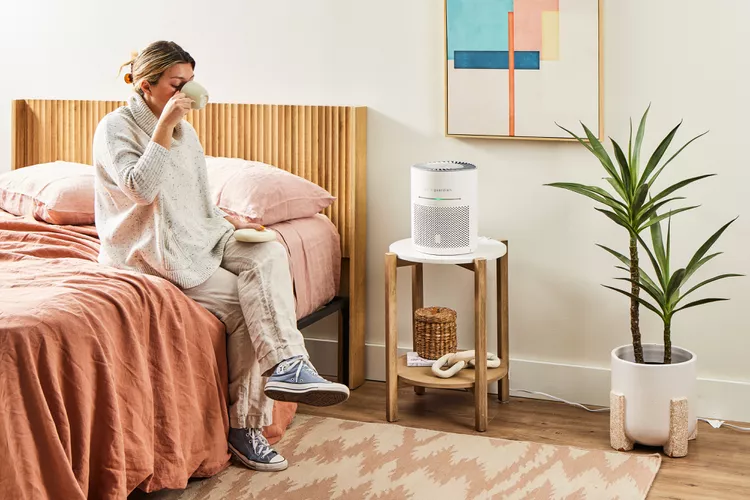Mold isn’t just an eyesore, it’s an invisible health hazard that spreads through the air you breathe. Even after scrubbing away visible spots, lingering spores can keep circulating and triggering allergies or respiratory issues. This article breaks down how air purifiers tackle mold at its source, what types actually work, and how to use them effectively to keep your home clean, safe, and mold-free.
Why You Need an Air Purifier for Mold at Home
Mold needs three things to grow: moisture, organic material, and poor ventilation. Any damp surface, like drywall, carpeting, or bathroom grout, can become a breeding ground if humidity stays above 60%.
The problem isn’t just what you can see. Mold releases microscopic spores and mycotoxins into the air, which irritate your lungs, trigger allergies, and can cause chronic sinus or respiratory problems over time. Essentially, it turns your air into a low-level pollutant source, especially dangerous for kids, seniors, and anyone with asthma.
When air circulation stops, like in corners, behind furniture, or inside HVAC vents, humidity becomes trapped, and dust and organic particles act as “mold food.” Once it starts growing, mold aerosolizes spores that ride your HVAC currents like microscopic hitchhikers. You breathe them in, your fabrics absorb them, and your home starts to smell faintly earthy or “wet.” That’s when air quality takes a dive, long before you see visible growth. That’s also when an air purifier mold solution starts making a real difference.
How Air Purifiers Work Against Mold
An air purifier for mold acts like a continuous filter that boosts your indoor air quality and helps your home feel fresher. A fan pulls air through one or more filters that capture particles or neutralize chemicals before releasing cleaner air back into the room.
Depending on the type, air purifier mold removal systems can use HEPA filters to trap particles like dust, pollen, and mold spores, activated carbon filters to absorb odors and volatile organic compounds (VOCs), or UV-C light systems to break down microorganisms such as bacteria, viruses, and mold spores on a molecular level.
Most people think air purifier mold devices are like vacuums for air. In reality, they’re more like airflow regulators, constantly pulling, trapping, and resetting the air cycle so pollutants never build up enough to trigger symptoms. The best ones move the entire room’s air several times an hour, stripping out allergens, smoke, mold spores, and chemical vapors from cleaning products or furniture off-gassing.
In short, a well-designed air purifier for mold doesn’t just make the air look cleaner, it actively reduces the stuff that makes you sneeze, cough, or feel congested indoors. If your purifier doesn’t move enough air for your space, you might feel the fan, but you’re not getting cleaner air. That’s the difference between “having one” and “using one effectively.”
Do Hepa Filters Remove Mold
True HEPA filters are extremely effective at capturing mold spores, removing 99.97% of particles as small as 0.3 microns. Since most mold spores are between 1-30 microns, a quality HEPA filter can trap them with ease.
However, HEPA filters trap spores, they don’t kill them. If the trapped spores stay in a damp filter, they can still grow. That’s why regular filter replacement and keeping humidity below 50% are essential for real mold control. Pairing your HEPA unit with an air purifier mold removal setup maximizes effectiveness.
When a HEPA filter fills up, it doesn’t just get dirty, it can become a petri dish with a fan attached if you don’t replace it on schedule. Keep your space below 50% humidity, and your air purifier for mold remains a mold catcher. Let humidity rise, and it becomes a mold farm.
Do Air Purifiers Help With Black Mold
An air purifier for mold doesn’t eliminate black mold from surfaces, but it reduces its airborne spores, which is crucial for controlling its spread and protecting your lungs.
Think of it this way: an air purifier mold system is your defense line, not your cleanup crew. It won’t remove mold growing behind drywall or under carpet, but it will keep spores from circulating and landing elsewhere to start new colonies.
Paired with proper remediation and dehumidification, air purifier mold removal becomes part of a powerful prevention strategy. The real win is breaking the reinfection loop, mold often comes back because spores keep circulating while you’re cleaning. A purifier running 24/7 during and after remediation helps stop that cycle cold.
Do Air Filters Remove Mold Spores
Air filters, especially HEPA and carbon types, trap mold spores effectively, but trapping isn’t the same as killing. Trapping means the filter physically captures spores in its fibers, preventing them from reentering the air.
Killing requires technology like UV-C light or antimicrobial coatings, which destroy spores or stop them from reproducing. A filter that only traps spores can still harbor live mold if it stays moist, so always replace filters on schedule and keep humidity in check. An air purifier for mold that combines UV-C and HEPA ensures both capture and neutralization.
Even then, “killing” isn’t a substitute for dryness. Dead spores can still trigger allergic reactions, they’re like pollen in that way. The real goal isn’t just killing mold; it’s keeping the air so clean and dry that mold doesn’t even try to grow again. That’s why air purifier mold removal systems work best alongside moisture control.
Best Air Purifiers for Mold: HEPA, UV-C, and Carbon
Multi-stage air purifier mold systems with a combination of HEPA, UV-C, and activated carbon are ideal for mold-prone homes. HEPA filters capture spores, while UV-C lamps damage their DNA so they can’t multiply. Activated carbon absorbs the gases mold emits, eliminating the musty odor associated with microbial growth.
Avoid cheap ionizers or ozone generators, they can irritate lungs and don’t actually solve mold issues. Look for an air purifier for mold that combines particle removal, sterilization, and odor absorption.
The best units use all three stages effectively: UV-C sterilizes spores that slip past HEPA filters, and activated carbon targets the odors HEPA can’t address. What truly sets a purifier apart is design, if air doesn’t linger long enough under UV light, spores survive. Placement, airflow path, and dwell time matter more than marketing claims. Proper air purifier mold removal design ensures spores don’t get a second chance.
Can an Air Purifier Mold Setup Stop Mold Growth
Not on its own, but it’s an excellent supporting player. Mold prevention starts with moisture control, so a dehumidifier or good ventilation system should come first. Regular dryer vent cleaning also plays a part here, since a clogged vent traps moist air indoors and adds to the humidity problem.
An air purifier for mold complements that by capturing spores before they settle and take root. In rooms like basements or bathrooms, pairing a HEPA air purifier mold system with a dehumidifier keeps the environment dry and spore-free, a powerful one-two punch against mold growth.
Air purifiers don’t dry the air, but constant circulation keeps humidity from concentrating in dead zones like closets or behind drapes. Paired with a dehumidifier, this creates an active microclimate system, dry air in motion that makes life hard for mold. It’s about synergy, not single tools, and that’s the foundation of effective air purifier mold removal.
Using an Air Purifier for Mold with Other Methods
Use them as a layered defense system. Clean and remove visible mold first, purifiers can’t fix existing growth. Then dry the environment with a dehumidifier to keep humidity under 50%. Once the space is dry and clean, run your air purifier for mold in the same area to capture spores stirred up by cleaning or daily activity.
Maintain your filters and monitor humidity, dirty filters or high moisture undo all your hard work. This combination removes both the source and symptoms of mold, creating a sustainable, healthy environment instead of a temporary fix. If you skip steps or do them out of order, you’ll just be chasing symptoms, it’s like treating smoke but ignoring the fire. That’s why ongoing air purifier mold removal is essential for long-term prevention.
Choosing the Right Air Purifier for Mold Problems
Look for purifiers that are specifically tested and certified for particle removal efficiency and safety. Choose models with True HEPA certification (not “HEPA-type”), an AHAM Verified CADR rating appropriate for your room size, and a sealed system design so air can’t leak around the filter.
Features like UV-C or antimicrobial technology add protection, while an activated carbon stage helps control odors and VOCs. Smart sensors or humidity monitors provide continuous air-quality feedback, and a purifier should maintain steady airflow (ACH 4-5x/hour) for your room volume.
Avoid units that rely on ozone or ions, they’re outdated and can worsen respiratory issues. The best air purifier mold solution doesn’t just filter air; it helps maintain an environment where mold can’t thrive. If a brand doesn’t publish these specs, it’s marketing, not science. When done right, air purifier mold removal turns your purifier into a true mold-prevention system rather than just an accessory.
Keep an eye for more latest news & updates on Web Of Buzz!




